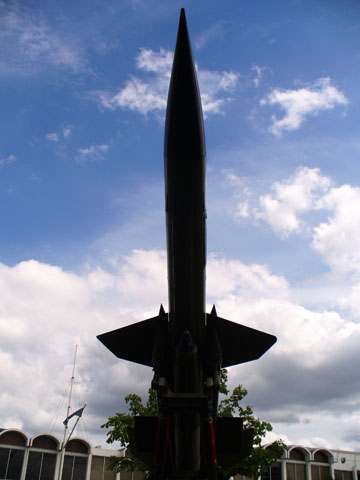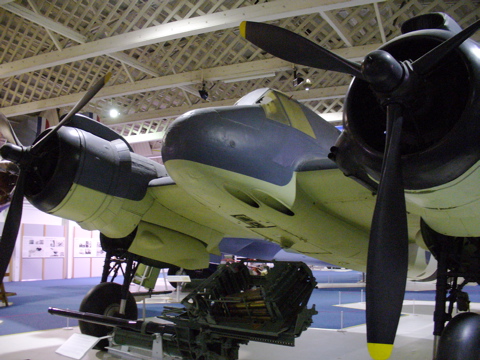
Cranwell is a RAF base in Lincolnshire (not far from Newark or Grantham, or Lincoln for that matter). It was first established as a RNAS training station in 1915, and sortied the odd anti-zepp patrol in the next few years. In the 1930s, Frank Whittle did much of his work on jet engines here; indeed, the first flight of the Gloster E.28/39, on 15 May 1941, was from Cranwell. But it is best known as the home of the RAF’s officer training college, RAF College Cranwell (but usually called Cranwell, just to confuse things). The College was founded in 1919, and the rather splendid College Hall, seen above, opened for business in 1934.

On 22 and 23 August 2007, I was fortunate to be able to attend a conference at Cranwell on the subject of “Air Power, Insurgency, and the ‘War on Terror'”. This was jointly hosted by the Air Power Studies Division of King’s College London, and by the RAF Centre for Air Power Studies (RAF CAPS), newly formed out of the Air Power Studies Division, Air Historical Branch, and Directorate of Defence Studies. The purpose of RAF CAPS is described as follows:
The Centre aspires to strengthen the relationship between academia and the RAF and to utilise the enhanced collaboration to develop and stimulate thinking about air power in both areas, as well as more broadly throughout the United Kingdom. The RAF CAPS is ideally placed to enhance the RAF’s current and future operational effectiveness by improving the ability of the Service to apply lessons from the past to both the present and the future.
This is a very worthwhile endeavour, and I wish RAF CAPS every success. They’ve made a good start with their website: there’s a page for job listings, a link to Air Power Review (which they are now responsible for), and even a space for a blog, though it’s currently empty.
Staying on a RAF base for a night was a novel experience. In fact even before I got onto the base, I sat behind an Air Chief Marshal (retired) on the bus, which was stopped at the gates by a young woman with a very big gun. But I’m too much of a civilian to have enjoyed even the minimal restrictions I had to observe as a guest (I’ve already mentioned the tie thing) — I never would have made it in the military!

That’s the lawn in front of College Hall; you could land a 504K on that … quite possibly the intention!
The conference itself was of a high standard. Its purpose was to examine the role played by airpower in past counter-insurgency operations and to try to draw lessons for current and future wars. So, the papers were a mix of historical case studies, reports on operations in Iraq and Afghanistan, and broader overviews — more war studies than history. Of course, the historical papers were of most direct interest to me, particularly those dealing with RAF air control policies: Group Captain Neville Parton’s “Air power and insurgency: early RAF doctrine” (which showed the evolution of air control doctrine, and made the very good point that unlike strategic bombing, air control operations constituted the RAF’s concrete experience of bombing in the interwar period) and Air Vice-Marshal Peter Dye’s “Royal Air Force operations in southwest Arabia 1917-1967″ (fascinating to see the continuities over such a long period, but also how political changes, both international and local, made air control policies more difficult to sustain). Probably the most enjoyable papers were some of those on operations I knew little about: for example, Richard Grossman’s “‘Looks suspicious’: the U.S. Marines’ air campaign against the Sandino insurgents of Nicaragua, 1927-1933′ (a real eye-opener: poor intelligence and little understanding of the cultural context often led to bombing of civilians with no connection to the insurgents, which oddly enough was counterproductive), or David Jordan’s “Air power in urban insurgencies: the battles of Surabaya and Fallujah” (in both cases good intelligence was gathered beforehand and drastically improved effectiveness). Of course, there was much on present-day operations too, and there were attempts by distinguished historians like James Corum and Phillip Meilinger to draw more general principles about the application of airpower in the 21st century.
The participants were probably 70% military (mostly RAF, of course). I was impressed by the attentiveness of the senior officers (the Chief of Air Staff was in attendance) to the conclusions drawn by the various speakers: this conference was not for show, or a mere academic exercise, but a real attempt to learn from the successes and failures of the past. Nor were they only interested in learning how to destroy things more efficiently, or in a more discriminating fashion: there was much discussion of non-lethal uses of airpower, such as for reconnaissance or even just keeping the enemies’ heads down, restricting their mobility. (Which strikes me as a return to 1914 conceptions of airpower, in some ways.) Having said that, my favourite new phrase from the conference was undoubtedly “the kinetic effects of airpower”, meaning precisely the ability to destroy things from the air, using the awesome power of kinetic energy. As an ex-physicist, that’s a phrase I can get on board with!
Speaking of King’s and war studies, I’ve recently come across an excellent group blog called Kings of War, run by three KCL War Studies academics: David Betz, Theo Farrell and Patrick Porter. Only occasionally historical, but it’s still good clean fun.
![]() This work is licensed under a Creative Commons Attribution-NonCommercial-NoDerivatives 4.0 International License.
Permissions beyond the scope of this license may be available at http://airminded.org/copyright/.
This work is licensed under a Creative Commons Attribution-NonCommercial-NoDerivatives 4.0 International License.
Permissions beyond the scope of this license may be available at http://airminded.org/copyright/.





Brett, this is Cranwell RAFB, right?
Sorry, but didn’t read the complete post. This was the airship base. Did you see the hangars?
Actually, I didn’t realise it was used for airships too — the Navy did have a lot of them by the end of WWI. Are there really still airship hangars there, though? Or are you thinking of Cardington? That was the centre for the really big airships after the war.
Anyway, I definitely didn’t see any, as I didn’t think it sensible to go wandering about about the base, what with the armed guards and all!
Don’t quote me on this, but I think that the sheds at Cranwell (by then RAF, even if ex-RNAS) had been demolished by the time the college moved in. I don’t think that any were big ones for rigids. Of the Cardington sheds (wot I have just gone past in a train), one was built there, the other was orginally at Pulham in Norfolk. The third big shed base was Howden, IIRC.
If you go to maps.google.co.uk and search for “cardington, bedford”, on satellite or hybrid view (or click here), the sheds are easily visible even on the default magnification. Those things are big! Here’s a close-up.
Brett: many thanks for the nice comment about KOW. And I’m also delighted to hear that my colleagues at Cranwell organised such a good Air Power conference.
No worries, Theo, and I’m still enjoying it. I don’t keep tabs on contemporary military stuff as much as I probably should, and KOW is a refreshingly non-political and non-American way of doing so (not that there is anything particularly wrong with either of those, but it’s easy to find both in the blogosphere without even trying). So, keep up the good work!
Pingback: The St Eval Incident | Airminded